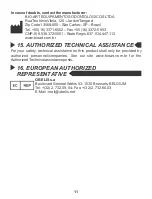
9
12. PROBLEMS AND SOLUTIONS
11. SPECIAL STORAGE CONDITIONS
• The aluminum oxide used in Microblaster might cause skin, eye and respiratory
tract irritation. Never use Microblaster without personal protective equipment
(PPE).
• Never use aluminum oxide with traces of moisture or contaminants.
• Never use aluminum oxide with granulation out of the manufacturer's
specification (up to 100 Microns).
Bio-Art Microblaster shall be stored under the following conditions:
• With the clamp installed on the switch button (04), keeping it always pressed.
• Always disconnected from the compressed air network and/or the equipment;
• In a cool, dry and free of dust place;
• Far from chemical products and protected from sources of heat and sun light;
• Preferably in its original packaging.
Problem Cause Solution
Air and/or abrasive
flow missing, or
insufficient at the
ejecting needle
(01) ***.
Clogging***.
Air leaking on the
Microblaster body.
Air leaking through the
ejecting nozzle needle.
See item 6 of this user manual
and install Microblaster correctly.
See item 6 of this user manual
and monitor the correct pressure,
(60 to 80 lbf/inch² (4~5.5 Kgf/cm² ).
Fill the tank (06) in with aluminum
oxide at maximum of 3/4 of its capacity.
The compressed air network shall be dry.
Check the coalescent filter efficiency
and the presence of moisture.
The abrasive shall be free of moisture, with humid
weather it is necessary to pre-dry in an oven
or an open pot at 250°C for 30 minutes.
Use only abrasive of the type aluminum oxide
up to 100 microns, preferably supplied
by Bio-Art itself.
The excess of aluminum oxide in
the blasting shall be disposed.
Contact the Authorized Technical
assistance Service.
Contact the Authorized Technical
assistance Service.
Incorrect connection of
Microblaster to the compressed
air network.
Insufficient or instable
compressed air
network pressure.
Throttling of the driving hose
by the button lever.
See item 7, part 4 of this user manual.
Insufficient quantity
of abrasive (aluminum oxide)
in the tank (06).
Presence of moisture in the
compressed air system.
Presence of moisture in
the abrasive.
Incorrect granulation, out of
specification in the user
manual.
Reuse of abrasives containing
residues (“recycling" attempt).
Internal driving hose damaged.
Displacement of the driving
lever internal hose.
































